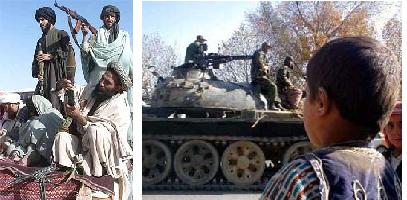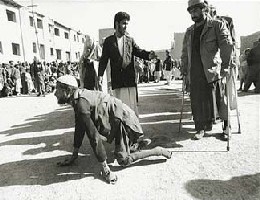|
By
Linda S. Heard
Afghans
have historically received a rough deal. When the
Soviets were in town, there were more than one million
deaths, and millions more maimed or rendered homeless.
Soviet soldiers have been accused of torching entire
villages and dousing Afghans with gasoline before
lighting a match.
Afghans barely had the chance to celebrate the departing
Soviet armies when the Northern Alliance ostensibly took
charge and the country was hurtled into a period of
internecine strife turning cities into rubble. Then came
the Taliban with their obscene oppression of women and
girls, public floggings and amputations.
But have the U.S. cavalry and their smartened up
Northern Alliance buddies, disingenuously wearing
democracy’s flag, behaved any better?
Not much according to Duncan Campbell and Suzanne
Goldenberg of the Guardian newspaper, Human
Rights Watch and the award-winning Irish filmmaker Jamie
Doran. For many Afghans ‘Operation Enduring Freedom’ has
been their worst nightmare.
Violent Abuse And Humiliation
In
an article dated June 23, 2004, Campbell and Goldenberg
report on violent abuses and sexual humiliation taking
place in “America’s secret network of Afghan jails”.
They write of the anguish of 47-year-old former police
officer Syed Nabi Siddiqi who was arrested by the
coalition forces last year. Siddiqi recounted how
“American soldiers stripped him naked, photographed him,
set dogs on him and told him his wife was a prostitute”.
The article reads: “An in-depth investigation by the
Guardian, including interviews with former Bagram
prisoners, senior U.S. military sources and human rights
monitors in Afghanistan, has uncovered widespread
evidence of detainees facing beatings, sexual
humiliation and being kept for long periods in painful
positions.
“Detainees, none of whom were ever charged with any
offence, told of American soldiers throwing stones at
them…and being stripped naked in front of large groups
of interrogators. One detainee said that, in order to be
released after nearly two years, he had to sign a
document stating that he had been captured in battle
when, in fact, he was arrested while driving his taxi
with four passengers in it.”
“They said this is America…if a soldier orders you to
take off your clothes, you must obey” goes the article’s
bold headline.
Noor Aghah, a 35-year-old father of four, who was
detained in both Bagram and Gardez said that he was
forced to drink 12 bottles of water and was not allowed
to go to the toilet. He describes how he and others were
handcuffed and forced to kneel in a “narrow open space
between two high walls with direct sun coming down on
them for 10 hours during the day”.
A
report by Human Rights Watch published earlier this year
accuses the U.S of holding detainees indefinitely in a
“legal black hole” without any checks and balances and
of endangering the lives of civilians by using
helicopter gun-ships in heavily populated residential
areas. It complains of “cowboy-like” tactics having been
used against people “who generally turn out to be
law-abiding citizens” including the use of hand-grenades
to blow open doors instead of knocking.
Said Brad Adams, Human Rights Watch Executive Director
Asia Division: “The United States is setting a terrible
example in Afghanistan on detention practices…Civilians
are being held in a legal black hole with no tribunals,
no legal counsel, no family visits and no basic legal
protections”.
Convoy of Death
Disturbing
reports about the fate of up to 3,000 alleged Taliban
fighters at the hands of Northern Alliance warlord
General Abdul Rashid Dostum with the complicity of the
U.S., have been circulating since December 20, 2001 but
to date no official investigation has been authorized.
Allegations, which began as hushed rumours, have now
been fleshed out by the stomach-churning first-hand
accounts of three British detainees, released from
Guantanamo’s Camp Delta earlier this year. The findings
of pathologists commissioned by the United Nations to
unearth mass graves, and a gruesome documentary,
produced and directed by Jamie Doran have lent
credibility to their stories.

The deaths reportedly took place between Qala-I-Zeini
fortress, Sherberghan prison and the desert sands of
Dasht-I-Leili during a four-day period. Doran says U.S.
personnel were complicit in war crimes but the Pentagon
has denied that American soldiers were even in the
vicinity or that the U.S. army had any knowledge that
such a massacre had taken place.
“We can now reveal the Pentagon was lying,” the Irish
filmmaker asserts.
Witnesses have confirmed that there were around 150
Americans at Sherberghan at the time of the shocking
incident and Doran says a picture taken on December 1,
2001 “confirms the U.S. presence”.
Afghan Massacre: The Convoy of Death
is the name of Doran’s one-hour long documentary, which
graphically catalogues the massacre of up to 3,000 men –
presumed to have been fighting for the Taliban – some of
whom surrendered after the Siege of Kunduz, once they
had received assurances they would be safe.
According to Doran’s documentary, others had been handed
over to the Northern Alliance simply because they spoke
Pashto. Villagers were shown being threatened by Dostum
himself to yield up Taliban suspects or else. Doran
didn’t realize it at the time he made his film but three
out of the 3,000 captured were British school friends
from the West Midlands’ town of Tipton, who became known
as the Tipton Three.
The Convoy of Death reveals eyewitness testimony
concerning the way in which detainees were crammed into
airless containers and left to suffocate as temperatures
soared. When the prisoners cried out that they could not
breathe, their guards fired at the containers
indiscriminately killing and wounding detainees in the
process.
One of these soldiers told Doran: I hit the container
with bullets to make holes for ventilation. Some of them
were killed. I noticed that blood was running from the
containers…”
In
the film, survivors talk of licking the sweat off dead
bodies and biting others so as to obtain moisture in any
form, accounts that were later corroborated by the
British detainees.
Another of Dostum’s paramilitaries describes the scene
when the containers were first opened at Sherberghan
prison. “I shall never forget the smell as long as I
live. It was a smell to make you forget all other smells
you have ever experienced in your life”.
Many of the Pakistanis, Chechans, Arabs, Afghans and
others who managed to survive the horrendous four-day
ordeal were allegedly eventually taken to Sherberghan
Prison from where they were transported to the desert
along with the corpses of their fellow prisoners and
shot down in cold blood.
A
witness in Doran’s film said: “All the sick and injured
were transferred to my trucks and we brought them to the
area we are in now. They took them to different sections
and they shot them.”
Drivers showed Doran and his crew where they were
ordered to take the bodies. Initially the committed
Irishman was hesitant in publicizing the location,
fearful that evidence would be tampered with in an
effort to cover up the crimes.

When one of the drivers was asked how many Americans
soldiers had been at the scene, he answered “lots of
them…maybe 30 or 40”.
Like the Pentagon, Dostum has refuted the allegations,
claiming that only 3,000 to 4,000 fighters had
surrendered at Kundoz and they were accounted for.
However, one of his own generals appears in Doran’s
film, saying that he personally counted over 7,000
before handing them over to his men for transportation
to Sherberghan.
So
are the bodies of the missing 3,000 to be found under
the Dasht-I-Leili sands? Forensic anthropologist William
Haglund indicated to Britain’s Observer newspaper
that they might be. He describes how he had exhumed 15
bodies from their resting place near Sherberghan for the
purpose of carrying out autopsies.
His conclusion was “they died from suffocation” in
keeping with the claims of the Tipton Three and Doran’s
eyewitness reports. Haglund suggests the 15 might well
represent the tip of the iceberg.
If
these reports are not true then any enquiry would surely
clear the air and add to the coalition’s credibility,
given that whoever is accused of such atrocities would
have been subject to its command and control structure.
Its continued silence only fans the accusatory flames.
If
American soldiers or intelligence officers were, indeed,
complicit in the murder of thousands of prisoners or
were found to be silent observers, then they should
surely be charged accordingly. If not, then one must
wonder why the Pentagon isn’t eager to clear its name.
 Doran
maintains that all the eyewitnesses in his Convoy of
Death are willing to cooperate with any
investigation so long as their personal safety is
guaranteed. If those vulnerable individuals are
courageous enough to speak out and even, in some
instances, willing to confess to their own horrendous
misdeeds, then the coalition should have the gumption to
break its wall of silence and get at the truth, as
painful as that might be. Sadly two out of the four
witnesses are now dead. Doran
maintains that all the eyewitnesses in his Convoy of
Death are willing to cooperate with any
investigation so long as their personal safety is
guaranteed. If those vulnerable individuals are
courageous enough to speak out and even, in some
instances, willing to confess to their own horrendous
misdeeds, then the coalition should have the gumption to
break its wall of silence and get at the truth, as
painful as that might be. Sadly two out of the four
witnesses are now dead.
Unfortunately, this wall of silence also extends to the
U.S. media. While the documentary has been broadcast
globally on various television networks and viewed by
members of the European Parliament, as well as by
various human rights groups, it has been completely
ignored by mainstream American newspapers and networks.
New York Times
articles have dealt extensively with accounts by the
Tipton Three of abuses they and others allegedly
experienced in Guantanamo, as these are widespread and
common knowledge, but all the papers’ articles have
excluded the three’s harrowing reports of Northern
Alliance brutalities in Afghanistan, including the
Convoy of Death.
The ‘Convoy of Death’ is unlikely ever to be
investigated as the Pentagon refuses to launch an
enquiry. A spokesman for the State Department told Doran
that the U.S. would only consider a probe of the
possible Afghan involvement in the alleged slaughter,
but would not subject its own troops to scrutiny.
Despite this U.S. government policy of impunity for its
own, and its attempts to exempt its own soldiers from
the jurisdiction of the International Court, the current
treatment of prisoners in Afghanistan is, nevertheless,
attracting attention after the ugly revelations
concerning Iraq’s Abu Ghraib.
Democrat Senator Patrick Leahy, who is a member of the
Senate Subcommittee on Foreign Relations, has campaigned
against the prison abuses. He told the Guardian
that the abuses in Afghanistan were just as bad as those
perpetrated at Abu Ghraib, “but because there were no
photographs – at least, to our present knowledge – they
have not received enough attention.
“Prisoners in Afghanistan were subjected to cruel and
degrading treatment, and some died from it. These abuses
were part of a wider pattern stemming from a White House
attitude that ‘anything goes’ in the war against
terrorism, even if it crosses the line of illegality.
Not only should these incidents be thoroughly
investigated and the perpetrators punished, but we need
rules to prevent it from happening again”, he said.
Afghan Massacre:
The Convoy of Death, produced and directed by Jamie
Doran can be viewed at
http://www.informationclearinghouse.info/article3267.htm Al
Shindagah magazine is not responsible for the content of
external websites.
| 